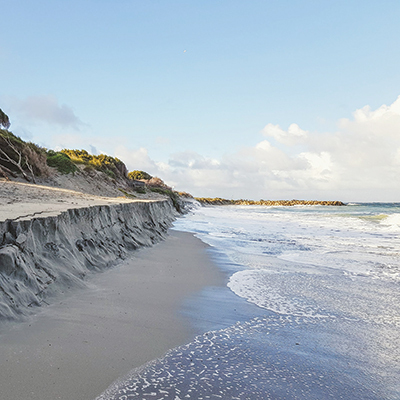City of Cockburn will host Western Australia’s first full-scale trial of an engineered reef designed to slow down coastal erosion by breaking down wave energy reaching the shore.
The reef modules will be constructed from a low carbon concrete, similar to those used at the City’s award-winning Coogee Maritime Trail.
The City has welcomed State Government coastal grants totalling nearly $274,000 to help fund the engineered reef to address persistent and costly erosion at C. Y. O’Connor Beach in North Coogee.
A grant of $214,349 from the Coastal Adaptation & Protection Grants program 2021-22 will help install nearshore engineered reef modules up to 100m in length about 50m offshore from an area of beach that has experienced persistent erosion for more than 20 years.
Another sum of $59,630 will be used to bury a Geotextile Sand Container (GSC) wall in the onshore dunes adjacent to the reef, to act as an erosion ‘backstop’ to protect park assets in rare super-storm events.
Installation is proposed for early 2022, while the GSC wall will likely be installed in spring 2021 or autumn 2022 to coincide with routine sand nourishment at the popular beach.
The City is in discussions with local company Subcon to deliver the project in collaboration with The University of Western Australia, however a formal agreement is yet to be signed.
City of Cockburn Marine and Coastal Engineering Officer, Jonathan McKay said the reef had the potential to control erosion while having minimal impact on the beach, as opposed to more obtrusive conventional groynes and seawalls.
“During community consultation in 2019, feedback indicated options that minimise impact on the appearance and function of the beach were more desirable.
“The information we gain about the reef’s performance over many years will inform the understanding and design of similar ‘engineering with nature’ erosion protection initiatives in Western Australia and around the world.
“While erosion will still occur to some degree, it will happen at a reduced rate, minimising the quantity and frequency of sand nourishment, and allowing for a greater, more stable sand dune buffer to establish along the shoreline.
“The modular reef can be reconfigured, reduced or extended if required. Over time, the reef modules will be colonised by marine flora and fauna as has occurred at the underwater Coogee Maritime Trail, creating another marine habitat that will also be accessible to divers and snorkelers.”








